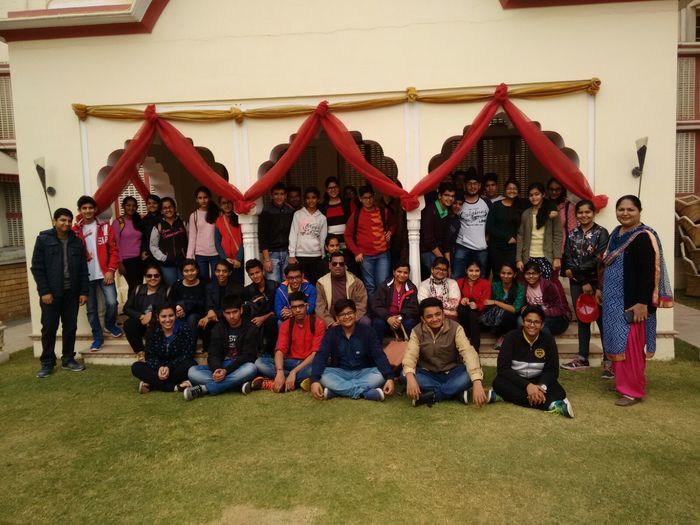Excursion to Mandawa
On 4th January 2016, 40 students of classes VIII, IX and X along with their teachers Ms. Sandhya Batheja, Ms. Sahodra Pawaiya, Mr. Pallabh Roy and Mr. Sanjeev Choudhary set out on a bus journey to Mandawa, a small town in the Shekhawati region of Rajasthan. The destination was selected to acquaint students first hand of a time when Indian tradesmen travelled from India to the Middle East and Europe on the famous Silk route. After all Shekhawati was once the centre of the bustle of merchants armed with spices heading to trade with the Arabs, Iranians and Europeans!
Shekhawati is a semi-arid historical region in the north east of Rajasthan comprising districts like Jhunjhunu, Sikar, Churu and Nagaur. History has it that in the 18th and 19th centuries, Marwari merchants constructed grand havelis in the Shekhawati region. Steeped in affluence, these merchants got busy outdoing each other by building grandiose edifices - homes, temples and step wells which were richly decorated both inside and outside with painted murals.
Frescoes were initially introduced by Shekhawat Rajputs in their forts and palaces. Infact the towns of Shekhawati are best known for their painted havelis. This region is also popularly called the "Open Art Gallery of Rajasthan" having the largest concentration of frescos in the world!
[gallery link="file"]
The Marwaris ( from Marwar) were an influential business community in Shekhawati, and they prospered until the beginning of the 19th century from the caravan routes that crossed this area to reach the ports of Gujarat. However, from 1820 onwards, many left their families behind and migrated to Calcutta, Bombay, and Madras, which were gaining importance as trade centres and where they could build bigger fortunes. Today, the descendants of these rich merchants have permanently settled down in the new cities their ancestors migrated to, leaving behind the beautiful havelis in the shadows of anonymity. The magnificence of these havelis has however not diminished and now they are a major tourist attraction.
As described, between 1830 and 1930, the Marwaris erected buildings in Shekhawati as symbols of their success. In fact as the special symbol of their opulence, the Marwaris commissioned artists to paint frescoes on the walls of the buildings. The frescos in these depict theological and historical themes. They include images of gods, goddesses, animals, and scenes from the lifes of Lord Rama and Krishna.
Mandawa is the the epicentre in many ways among places of significance in the area. Maharao Shardul Singhji of Jhunjhunu gave handed his legacy to his son Thakur Nawal Singh, who also founded Nawalgarh. Thakur Nawal Singh built the fort at Mandawa in 1755 AD.
In Mandawa, we visited both the Mandawa Fort and the Raghunath temple which were built 200
years ago. The interiors of Mandawa Fort have been influenced by the Sheesh Mahal of Amber Fort, and boasts extensive mirror work on the walls and the ceiling. The Durbar Hall is a grand portion of this Fort.
During princely times, the Late Ustad Mehdi Hassans forefathers were court minstrels of the Mandawa Thikana. Ustad Mehdi Hassan spent his childhood in the village Luna of Jhunjhunu district and gave his first performance in the court of Mandawa Thakur Saheb when he was still quite young.
There is a long list of tourist sites in Mandawa. Every street and house is painted with colourful frescoes. The fort, the wells and walls of the village are artefacts in themselves. The Hanuman Prasad Goenkas Haveli, Jhunjhunwalas Haveli, Saraf Haveli, Murmurias Haveli, Ladia Haveli, Chokhani and Newatia Havelis are some of the places we visited.
With architecture, themes and motifs reflecting the cultural sensibilities as well as aspirations of their owners, the Shekhawati havelis were designed to impress. The traders (banias) were as wealthy as the Rajput kings of the time, on account of a flourishing trade in opium, cotton and spices, but they were inhibited to build palaces and forts that compared with those of the royalty. As a result, they built havelis or mansions that drew inspiration from them. These were smaller, but nevertheless very elaborate. In the words of Ilay Cooper, author of The Painted Towns of Shekhawati, The haveli was to the bania what the fort was to the Rajput his home, his status, his headquarters and his defence.
If you were a commoner at the time (1830-1930) these were built, you might have looked in wonder at things you had never seen before an aeroplane painted on the outer walls or Belgian glasswork on the doors of a haveli!
The beautiful wall paintings that decorate the havelis of Mandawa have undergone changes in their themes from time to time. Whilst earlier mythology dominated the themes of the frescoes- local legends, animals, portraits, hunting and wrestling scenes, etc., the 19th century saw the themes reflect the British (Raj) influence on Indian culture. The traditional subjects were exchanged for cars, trains, balloons, telephones, gramophones, English men in hunting attires and portraits of the haveli owners immaculately dressed!
Other than a visit to these places, we also enjoyed a camel safari in the desert. On the ride we caught glimpses of village life in the desert along with its flora and fauna. We were curious about the farmers and empathised with their living conditions with scanty water supplies.
In the evening after a long and tiring day, we relaxed around a bon fire arranged by our hotel, the Udai Vilas Palace. There was also a cultural programme which showcased the traditions of Rajasthan. One of these was a traditional puppet show.
On the second day of the trip, we took part in kite flying and kabaddi too.
The three fun-filled days passed swiftly and we were sad to see them come to an end.
Ms. Sandhya Batheja.













